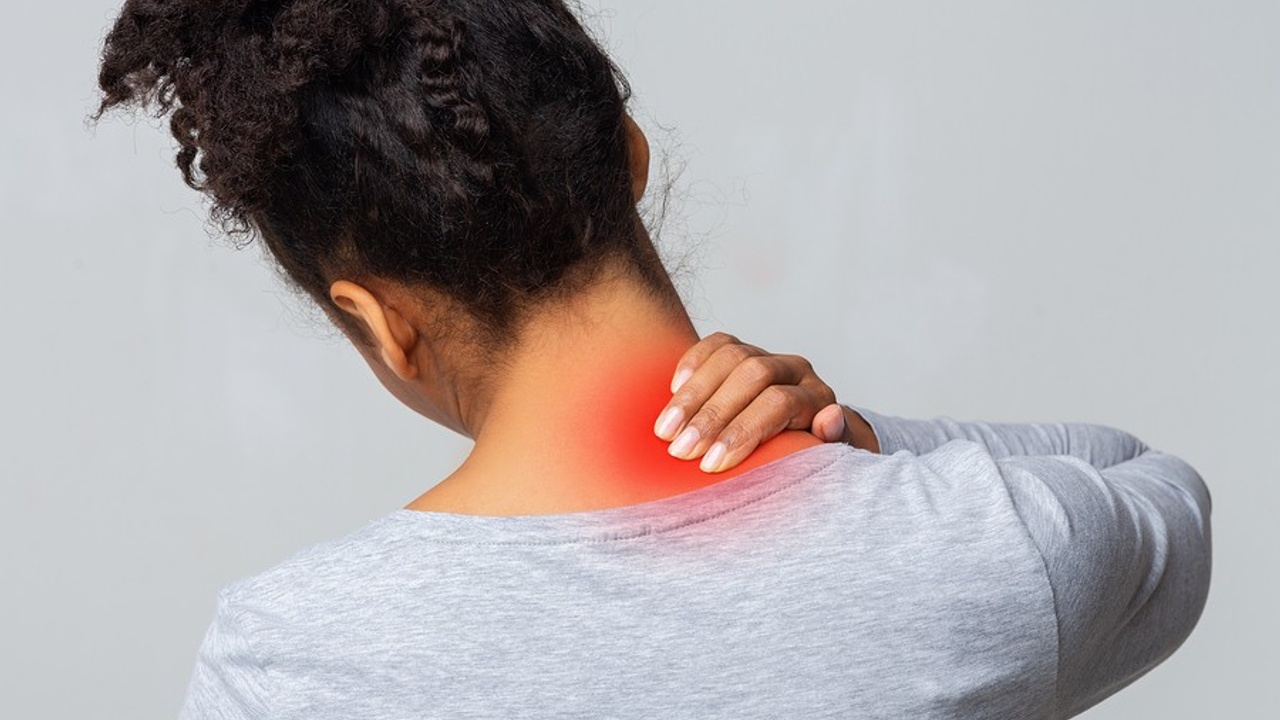Although the diaphragm and intercostals are the primary muscles of inspiration, several neck muscles play an accessory role in bringing air into the body. Furthermore, when these primary muscles of inhalation are not working optimally, or you are breathing heavily while exercising at a high level, the accessory neck muscles can become more active during respiration leading to breathing-related neck pain.
Neck pain is often a symptom of poor breathing patterns!
Breathing Fundamentals
“Breathing” just means a gas exchange between the body and the environment. When we breathe in, we take oxygen (O2) into our lungs. Then, when we breathe out, carbon dioxide (CO2) is released out into the atmosphere. Our biochemistry triggers our need to inhale. In other words, when receptors in our brain sense that CO2 concentrations have risen a certain amount, that triggers inhalation. So, we inhale to bring in more O2 to reduce the CO2 concentration. This, consequently, lowers the acidity of our blood.
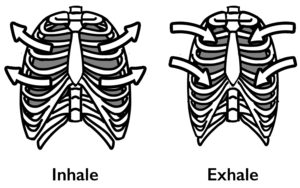 Inhalation is an active process that requires expansion of the lungs and rib cage within the torso.
Inhalation is an active process that requires expansion of the lungs and rib cage within the torso.
The diaphragm, a primary muscle of inspiration, divides the thoracic cavity, which contains the lungs, rib cage and heart, from the abdominopelvic cavity, which contains the pelvis and many of our internal organs. In a relaxed state, following exhalation, your respiratory diaphragm should be in a lifted, domed-up position. I say “should be” because this is not always the case. Issues with the diaphragm position and function can lead to chronic neck pain. (I will explain this more later.)
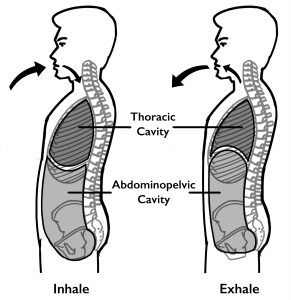
Here’s the process. When you inhale, the respiratory diaphragm moves downward into a stretched position, as shown in the image. The respiratory diaphragm descends into the abdominopelvic cavity. This reduces the pressure in the thoracic cavity and draws air into your lungs.
Primary Muscles of Inhalation
In addition to reducing the pressure in the thoracic cavity upon inhalation, the diaphragm also increases the volume of the thoracic cavity. The diaphragm is one broad muscle sitting at the base of the rib cage. It extends laterally in all directions from your center—forward, backward, and to both sides. Therefore, when it descends and flattens, it moves the ribs wider apart from the bottom of the cage. This then creates space for the lungs to expand as they fill with air.
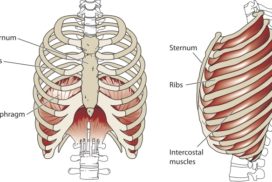
Besides the respiratory diaphragm, the intercostal muscles are primary muscles of inhalation. These muscles are located between each of the ribs. Their function in breathing, like the diaphragm, is to create more space in the thoracic cavity for expansion of the lungs and rib cage. They do this by elevating the ribs and expanding the chest from the sides.
Accessory Neck Muscles of Inhalation
Similar to the primary muscles of inhalation, the accessory muscles also assist in spreading and lifting the rib cage and chest. If overused, breathing-related neck pain can result.
Take a look at the Neck-muscles image. As you can see, there are three main muscles, including one group of three muscles, to focus on in the image. The scalene muscles (anterior, middle and posterior) and the upper trapezius muscle are on the back of the neck. Additionally, the sternocleidomastoid (SCM) muscle is equally important. It transverses from the front of the body and links the clavicle (collar bone) and sternum on the front of the rib cage to the temporal bone on the side of the skull.
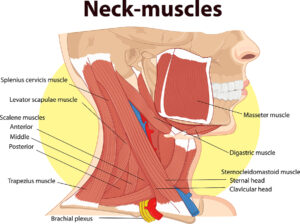
These accessory neck muscles perform the following functions during inhalation. First, the scalenes elevate the first and second ribs, creating more space at the top of the rib cage. Also, the upper trapezius lifts the rib cage to allow the upper chest to enlarge. Finally, the SCM aids in the front to back expansion of the chest by raising the sternum.
Related Blogs
My Low Back Hurts Because I Can’t Breathe
Belly Breathing Isn’t What You Think
Try Mouth Taping at Night to Improve Health and Performance
Are You a Neck Breather?
Try this simple test to find out.
Step 1: Start by placing your hands on each side of your neck. When you do this, try wrapping your hands around so that you can feel the back, sides and front of your neck. This helps you to determine which muscles are active during inhalation by their location.
Step 2: Next, breathe normally in and out through your nose. While doing this, notice any movement or tension that develops under your hands. Also, be aware that it may be different left to right.
Step 3: Now, forcefully inhale through your nose. Notice if there is a difference in the response of your neck muscles. Recall that as the effort of respiration increases, you should expect more involvement of the accessory neck muscles.
Step 4: Repeat steps 2 and 3, but this time, inhale through your mouth. Now think: What does that do to your neck muscles?
Step 5: Repeat the process again in different positions. In order to vary it, I recommend starting lying down on your back and then progressing to sitting, then standing. If you go in this order, it’ll provide a progressive increase in breathing demand. You may notice more neck involvement as you come into a vertical sitting position and even more when standing.
Reduce Your Breathing-Related Neck Pain with Exercises
In order to reduce your neck pain with breathing, you’ll need to strengthen your diaphragm and intercostals, the primary inhalation muscles. By doing so, the demand on your accessory breathing muscles is reduced and the scalenes, trapezius and SCM can stay more relaxed as you take a breath in.
When you breathe correctly, you strengthen your breathing muscles. So, practice breathing using the following steps.
First, position yourself so that your diaphragm is in a good posture vertically, opposite your pelvic diaphragm, with your rib cage and pelvis aligned. Lying on your back with your legs up is a good place to start. This alignment allows the diaphragms to move up and down as you breathe.
 Second, think of breathing down your body. Visualize the diaphragms lowering and lengthening as you inhale.
Second, think of breathing down your body. Visualize the diaphragms lowering and lengthening as you inhale.
Third, once you are consistently breathing down, focus on also breathing sideways. This will expand your intercostal muscles.
Fourth, keep in mind that inhaling is the focus for this breathing exercise. For the exhale, simply relax. Allow the air to escape from your body without effort.
Add Resistance to Your Inhale
When you’re at the gym, you add weight in order to add resistance to your exercises, right? Well, to increase the resistance of inhaling, you can narrow the airway. Or, you can use devices that increase the load on the respiratory muscles. Read on for more explanation!
Three Step Progression
- Begin increasing resistance by pursuing your lips like you would if you were using a straw.
- Next, use a straw. Straws come in different diameters. Start with a wider one and progress to a narrower one.
- Finally, consider a device that provides resistance that can change.
Throughout your breathing exercises, follow the cycle of inhalation in your body as you breathe down the torso. Remember that this engages the diaphragm to expand the rib cage. Then, feel the sides of your body swell as the intercostals stretch and as each rib rotates up and out away from the center of the body. Next, observe your chest opening as the upper lungs fill with air. In addition to noticing the growing volume in the front of your body, pay attention to the back of your body. It should expand in unison with the front. You may also want to place your hands on your neck to check that you are keeping these muscles relaxed while breathing.
Summary
In summary, you need to create space in the rib cage and chest so that the lungs can inflate when you inhale. The primary muscles of inspiration expand the thoracic cavity by pushing out from the bottom and sides using the diaphragm and intercostals. If these muscles are not well conditioned or are unable to do their jobs adequately, you can create more space by using the accessory muscles. These neck muscles (scalenes, trapezius and SCM) expand the thoracic cavity by pulling up on the rib cage from the top of the body.
If you align the torso and strengthen the primary inhalation muscles, you can reduce the effort required by the accessory inspiration muscles. Therefore, to reduce breathing-related neck pain, condition the diaphragm and intercostals. This is accomplished through breath training exercises, including adding resistance to the inhale.
Resources
- Kendall, F., McCreary, E., Provance, P., Rodgers, M. & Romani, W. (2005). Muscles: Testing and function with posture and pain (5th ed.). Baltimore,MD: Lippincott Williams & Wilkins.
- McKeown, P. (2015). The Oxygen Advantage. New York, NY: HarperCollins Publishers.
- Postural Restoration Institute® (PRI). (2017). Postural Respiration course: An integrated approach to treatment of patterned thoraco-Abdominal pathomechanics. Lincoln, NE: Postural Restoration Institute® (PRI).

